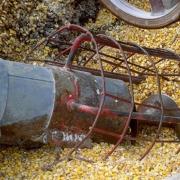
Use the following format to cite this article:
Mechanical hazards: Shear or cutting points. (2013). Farm and Ranch eXtension in Safety and Health (FReSH) Community of Practice. Retrieved from http://www.extension.org/pages/68264/mechanical-hazards:-shear-or-cutting-points.
A shear point hazard exists when the edges of two machine parts move across each other or move closely enough together to cut another object or move a relatively soft material. In a typical shear point hazard, one part moves while the other part is either stationary or moving. Cutting points occur when a single object moves forcefully or rapidly enough to cut another object.
Examples of shear or cutting points include the following:
- Hedge trimmers
- Windrow cutter bars
- Grain augers
- Sickle bar mowers
- Forage harvester cutter heads
- Rotary mower blades
Potential Injuries
Potential injuries from shear or cutting point hazards include amputation, lacerations, contusions, crushing of tissue, and broken bones. Due to the speed of mechanical parts, injury is inevitable when a body part comes in contact with a shear or cutting point. Projectile injuries can occur if an object is thrown from a cutting-type machine such as a rotary mower.
Shear and Cutting Point Safety Precautions
Follow the precautions below to reduce the risk of a shear point incident:
- Identify those types of machines that may have shear or cutting points.
- Make sure all covers and protective shields are in place on machinery and equipment. Replace heavily worn or broken shields.
- Wear clothing that fits well because close-fitting clothing is less likely to be pulled into moving parts.
- Remove any jewelry, tie or secure long hair under a hat, and remove drawstrings on hoods or jackets when working around shear point hazards.
- Turn off machines and wait for any rotating parts to come to a complete stop before beginning any type of maintenance.
- If a shield is removed to complete maintenance, make sure the shield is securely in place again prior to operating the equipment.
- Replace damaged manufacturer-installed warning labels and place warning labels on unlabeled areas.
- Never reach across a shear or cutting point hazard.
Resources:
Click here to view a video about shear point hazards from Pennsylvania State University’s Agricultural Safety and Health Program.
Click here to use the Farm/Agriculture/Rural Management—Hazard Analysis Tool (FARM-HAT) to determine the protection level of your auger.
Use the following format to cite this article:
Mechanical hazards: Shear or cutting points. (2013). Farm and Ranch eXtension in Safety and Health (FReSH) Community of Practice. Retrieved from http://www.extension.org/pages/68264/mechanical-hazards:-shear-or-cutting-points.
Sources:
Agricultural equipment and machine hazards. (2016) The Ohio State University. Retrieved from http://agsafety.osu.edu/programs/cfaes-osha/ag-equipment-machine-hazards.
American Society of Agricultural and Biological Engineers (ASABE). (2008) ANSI/ASAE S493.1. Guarding for agricultural equipment. St. Joseph, MI. Retrieved from http://elibrary.asabe.org.
Farm/Agriculture/Rural Management—Hazard Analysis Tool (FARM-HAT). (2010) Pennsylvania State University. Department of Agricultural and Biological Engineering. Agricultural Safety and Health. Retrieved from https://extension.psu.edu/farm-agriculture-rural-management-hazard-analy….
